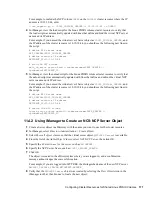
158
OES 2 SP2: Novell Cluster Services 1.8.7 for Linux Administration Guide
no
vd
ocx
(e
n)
7 Ja
nua
ry 201
0
NetWare-to-Linux failover requires that the Linux node be configured for NSS and that the
version of NSS supports the NSS media format and features being used by the NSS pool cluster
resource.
No storage management functions should be executed while a cluster is in a mixed-cluster
mode. Do not attempt to create, delete, expand, or modify the properties for partitions, pools, or
volumes for any shared resources in the cluster.
11.2 Creating Linux POSIX Volumes on Shared
Disks
The EVMS (Enterprise Volume Management System) provides a Cluster Segment Manager (CSM)
that helps prevent data corruption caused by multiple nodes accessing the same data. For this reason,
we recommend using EVMS to create Linux partitions, volumes, and file systems on shared storage
for use with Novell Cluster Services. EVMS virtual volumes can more easily be expanded and failed
over to different cluster servers than can physical devices. You can create partitions and volumes for
any of the journaled Linux file systems (such as Ext3 and ReiserFS). For information and examples
for using EVMS, enter
man evms
at the Linux terminal console to reference the
evms
man page.
WARNING:
EVMS administration utilities (evms, evmsgui, and evmsn) should not be running
when they are not being used. EVMS utilities lock the EVMS engine, which prevents other EVMS-
related actions from being performed. This affects both NSS and Linux POSIX volume actions.
NSS and Linux POSIX volume cluster resources should not be migrated while any of the EVMS
administration utilities are running.
Complete the tasks in this section to create a Linux POSIX volume and file system on a shared disk:
Section 11.2.1, “Removing Existing Formatting and Segment Managers,” on page 158
Section 11.2.2, “Creating a Cluster Segment Manager Container,” on page 159
Section 11.2.3, “Adding a Non-CSM Segment Manager Container,” on page 160
Section 11.2.4, “Creating an EVMS Volume,” on page 161
Section 11.2.5, “Making a File System on the EVMS Volume,” on page 161
For information about how to increase the size of an EVMS volume on a shared disk, see
Section 11.6, “Expanding EVMS Volumes on Shared Disks,” on page 176
.
11.2.1 Removing Existing Formatting and Segment Managers
The EVMS Cluster Segment Manager must be the first segment manager laid down on the space
you want to use for the shared Linux volume. Before you can assign the CSM to a partition, you
must make sure that the space is free of other formatting and segment managers.
WARNING:
Clearing the existing formatting for a device destroys all data on it.
EVMS by default shows unformatted free space on disks as compatibility volumes. If any of the
space you know to be free on the shared disk (that you plan to use in your cluster) is showing up as a
compatibility volume, you must delete the compatibility volume in order to see the space as being
free disk space.
















































